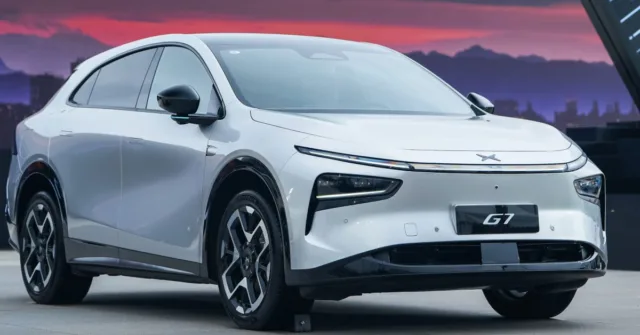
Xpeng has officially launched its new G7 electric SUV in China, entering the fiercely competitive electric crossover market with a starting price of just 195,800 yuan ($27,325 USD). The G7 is positioned squarely to compete with the Tesla Model Y and the newly unveiled Xiaomi YU7.
It is priced significantly more aggressively than the YU7, which shook up the industry just last week.
The G7, Xpeng’s seventh model, offers an attractive balance of performance, technology, and value, with an emphasis on the latter.
Like Lei Jun with the launch of the YU7 last week, He Xiaopeng was not shy about positioning the G7 against the best-selling Tesla Model Y.
He compared the specs and pricing with the leading premium crossover. Like Jun, he brought up Tesla’s comparison challenge against the new Model Y:

The G7 is powered by a single rear-wheel-drive electric motor producing 292 horsepower (218 kW), it achieves a 0-100 km/h acceleration in 6.5 seconds. Impressively, the G7 can cover between 602 km and 702 km (374-436 miles) based on China’s generous CLTC standard, depending on the battery option and wheel size.
Two battery options are available, both using lithium iron phosphate (LFP) technology: a 68.5 kWh and a larger 80.8 kWh pack. With Xpeng’s advanced 5C charging technology, drivers can recharge up to 436 km (271 miles) of range in just 10 minutes.
Additionally, the G7 supports Vehicle-to-Load (V2L) functionality, providing up to 6 kW of external power, like the YU7 announced last week.
On the design front, the Xpeng G7 adopts the company’s second-generation “X Face” styling, featuring sleek running lights connected by a continuous LED strip, a closed front end for aerodynamic efficiency, and a distinctive “Star Ring” rear taillight design. Xpeng emphasizes the vehicle’s aerodynamics with a drag coefficient of just 0.238 Cd, slightly higher than the Model Y’s 0.230 Cd.





Inside, the G7 embraces minimalism, replacing conventional buttons with a large 15.6-inch central touchscreen powered by Qualcomm’s Snapdragon 8295 chipset. A standout interior feature is the expansive 87-inch augmented reality head-up display (AR-HUD), developed in collaboration with Huawei, that significantly enhances navigation and driving assistance.
Practicality is emphasized with ample cargo space: an 819-liter trunk that expands to 2,277 liters with the seats folded, plus an additional 120-liter compartment beneath the trunk floor and a modest 42-liter front trunk (frunk).
Xpeng is touting an adaptive AI-driven suspension system that actively adjusts to road conditions within milliseconds, allegedly surpassing comfort benchmarks set by the Mercedes-Benz GLE and Tesla Model Y. Cabin quietness also ranks high on Xpeng’s list of priorities.
Luxury and convenience features include dual 50W wireless phone chargers, a 20-speaker premium audio system, and a panoramic sunroof. Passengers in the second row enjoy premium touches like an 8-inch control screen, individual climate settings, a foldable table, and wireless charging.
The top-tier “Ultra” variant employs two proprietary Turing AI chips capable of delivering a massive 2,250 TOPS of computing power, enabling advanced Level 3 autonomous driving capabilities set to become active via an OTA update by December 2025, pending regulatory approval. Standard versions use dual Nvidia Orin-X chips with 508 TOPS.
The Xpeng G7 starts at 195,800 yuan ($27,325 USD) for the base “Max” variant with 602 km of range, stepping up to 205,800 yuan ($28,720 USD) for the longer-range “Max” (702 km) and topping out at 225,800 yuan ($31,510 USD) for the high-end “Ultra” trim.
Customers ordering the G7 Ultra before July 31 will receive complimentary upgrades including Nappa leather and power door handles.
G7 quickly demonstrated its popularity by securing 10,000 pre-orders in just 46 minutes.
Electrek’s Take
It’s not 200,000 orders within 3 minutes like the YU7, but Xpeng doesn’t have the brand power that Xiaomi has.
Nonetheless, it is pretty impressive.
The price is insane. The specs are competitive with the Model Y, which starts at 263,500 yuan and ranges up to 313,500 yuan ($36,770 – 43,750 USD), but the price starts at about $10,000 USD less.
Between this, the YU7 last week, and a few more models launching this month, the premium crossover segment is about to get crowded in China.
I think the Model Y is in serious trouble in China. We are about to see how it fares with real competition.









